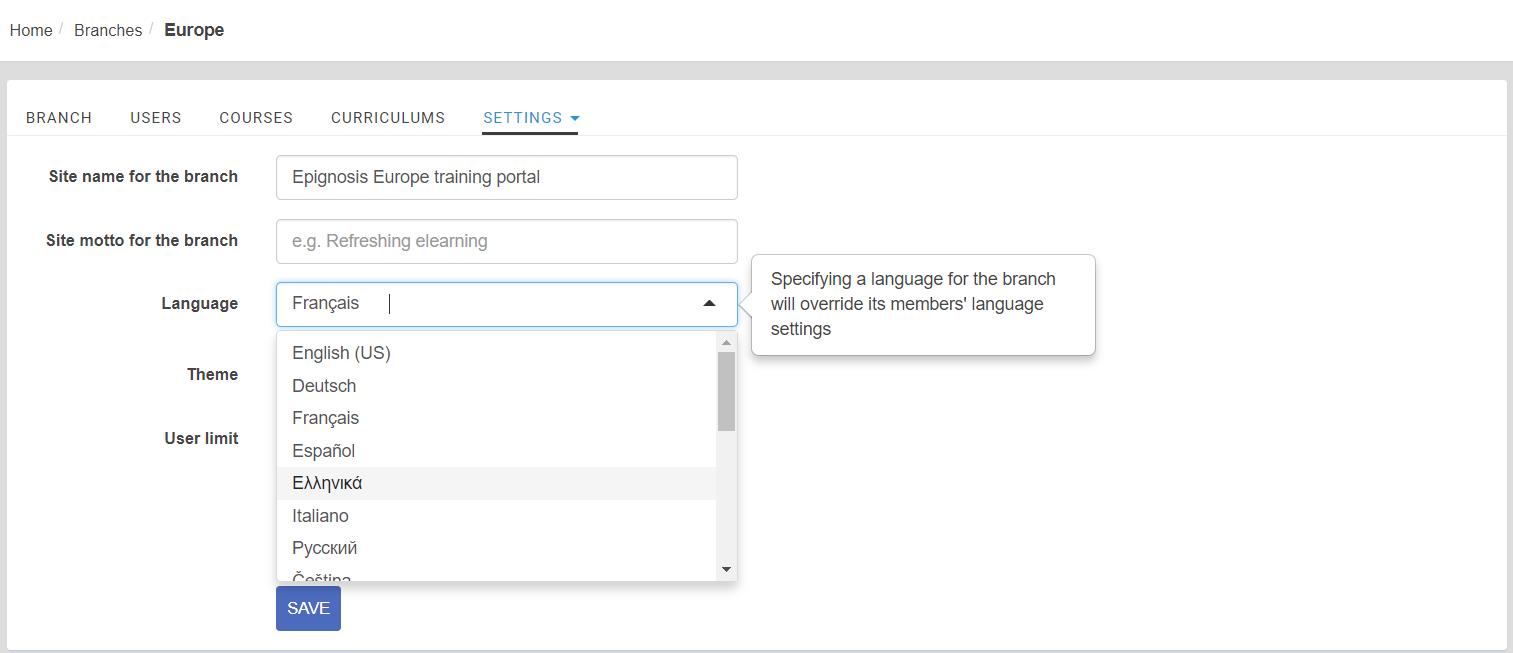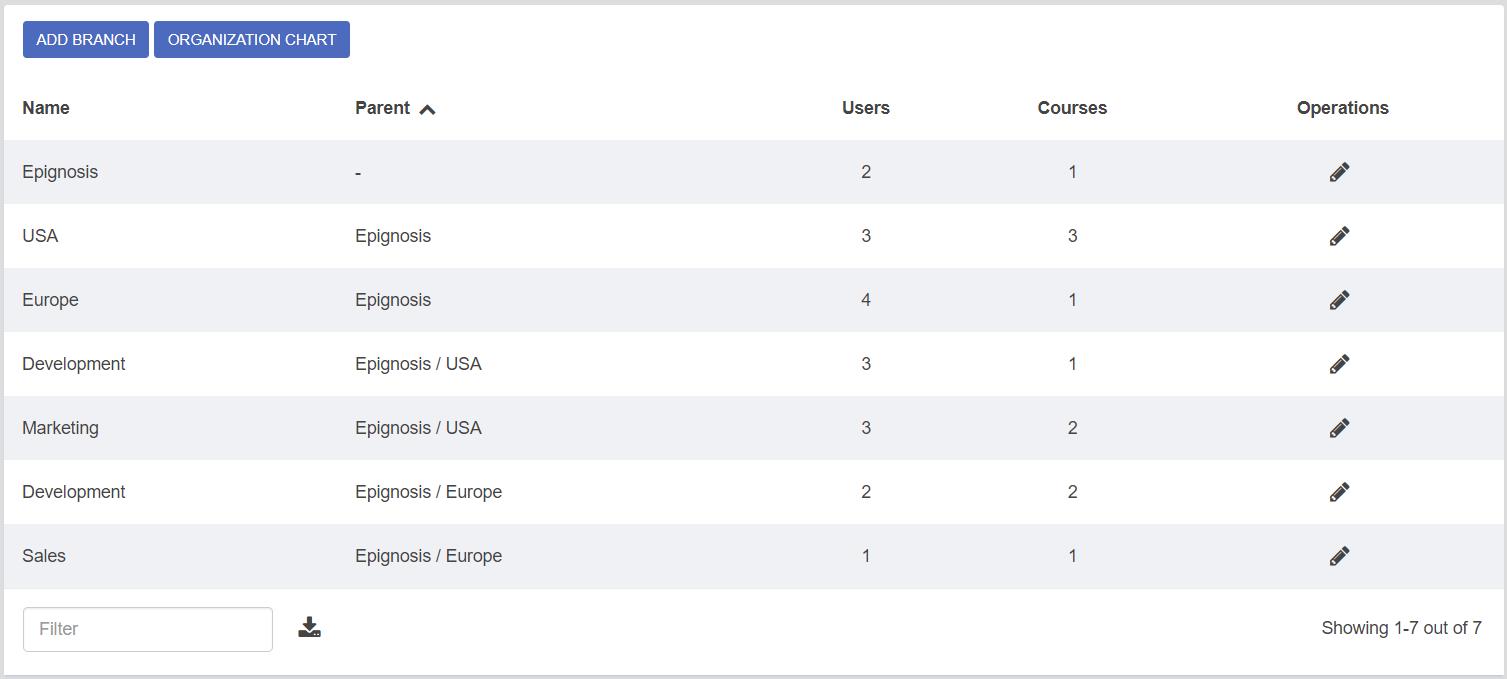Sorry — my editor just told me that that’s actually “brunch” — with a “u”.
What we’re concerned with in this post, is rather Branch with an “a”, the flagship eFront LMS feature.
With that cleared up early, let’s go see what branches entail.
The What of Branching
So what’s this branching then?
A branch is the name eFront gives to an independent, uniquely branded and configured eLearning portal that’s separate from your main eLearning portal, but is still created and managed from your eFront subscription.
eFront allows you to create an unlimited number of Branches off of your main eFront account for organizing your training. It’s free, and it’s as easy as giving a name to your new Branch and filling in some custom options for it (we’ll get back to this later in the post).
When learners are assigned to a Branch, they are taken to the Branch’s portal after logging in through your main portal (although you could also give each branch its own login address), and can only see the Courses and other LMS entities belonging to their assigned branch.
And that’s pretty much all there’s to Branches, concept-wise. It’s a feature that is simple to understand yet nonetheless has some distinct advantages over a single, monolithic eLearning portal.
What those are, we will examine in our next section, aptly titled…
The Why of Branching
Now that you know what Branches are, let’s see what some of the key benefits of using Branches are:
1) Better reflecting your organization
If not all of your employees belong to the same office/department/facility, etc., maybe your learners shouldn’t either.
Branches allow you to create individual eLearning portals that properly reflect your organizational hierarchy in all of its complexity.
Now for smaller companies, this might not make sense, but in company-wide training scenarios, that is if your medium or large company has different departments, branches, regional offices, and facilities, and if those have their own, unique, training needs, Branches will definitely help.

Ditto for companies that have to cover several different corporate identities (e.g. subsidiaries, conglomerates, merged companies, etc.) in their training program, and want to create separately managed and branded eLearning portals for each.
The same is true for companies that operate in an Extended Enterprise network, and have partners, local retailers, franchisees suppliers, etc. that they need to train.
2) Easier management
Since eFront’s Branches let you split your LMS installation into several independent but central run learning portals, you get the benefits of independent training environments without the extra hassle of having to configure, manage, and maintain separate LMS installations.
Following the good old “divide and conquer” approach, you will be able to administer, run, and monitor your training programs more easily if they are separated into individual Branches, not only on the IT/server administration level (since you have a single server and a single application instance to handle), but also on the day to day management within your portals.
A Branch instructor, for example, will only need to concern itself with the Branch’s own learners and courses.
3) Dedicated Branding
Different departments, regional offices, subsidiaries etc. of your company might have different branding needs (their own mottos, logos, colors, design language, etc.).
eFront allows each Branch to have its own logo, title, motto and visual theme (using HTML, CSS, and JS) so that it properly reflects the part of your organization that it caters to.
4) Better isolation
Branches allow users to have access to different sets of courses, shared documents, and so on, letting them only see the ones that are explicitly assigned to their own Branch.
Branches allow users to have access to different sets of courses, shared documents, and so on.Share on
That said, if you are a smaller company and you just want a way to split your learners into groups, Branches might be an overkill.
eFront already offers its Groups and Audiences features that help you easily create, well, groups of users and control what they can see, what courses they are assigned etc.
Chances are that if you don’t have more than a few dozens of learners, and if you can’t come up with a concrete use case for having separate eLearning portals, then you probably don’t need Branches.
If you do, however, and especially if you have more than one instructors, each dedicated to a different set of learners and a different set of courses, then you will probably appreciate the simplicity and isolation (“separation of concerns”) that comes with individual Branches.
5) Internationalization
The need for offering courses in different languages is related to being a company with multiple facilities, or one operating in an extended enterprise setting, and can be considered complementary to those scenarios.

(Besides, you might need to offers courses in several languages, even if your learners reside in the same country, e.g. of an NGO catering to different minority groups).
In any case, eFront’s Branches allow you to apply different language settings (this affects the user interface messages) and time zone settings (this affects event scheduling, notifications, etc.), and to have separately localized content (courses) for each of your branch-based portals.

The How of Branching
Branching, as we’ve already noted, is a simple concept in eFront. It’s no surprise, then, that it also has a simple (but powerful, don’t confuse simple with simplistic) implementation.
To view and manage your Branches, log in as an administrator, and visit the Branches section of the management page.
There, in the usual eFront format, you will see a tabular listing of any existing branches, with buttons to view, edit, and delete any of them, and add a new one.
To create a new Branch you just need to fill in the available fields (name, language, etc.) and click the “Add Branch” button.

Note that you are not limited to a flat list of Branches. By filling in the “Parent Branch” you can define a nested hierarchy of Branches (e.g. (/Partners/Germany/Foo, /Partners/Germany/Bar, etc. or Accounting/DeptA, Accounting/DebtB, etc.).
Once you have defined your Branches (and the above configuration is all there is to it), you can use them in various places across eFront.
You can, for example, restrict several Courses, Groups, Job functions, etc. to specific Branches, or you can ask to see reports that narrow down upon a certain Branch (or several).
Each training branch (and each tree of branches if you have nested them hierarchically) has no knowledge whatsoever of the existence of other branches and is thus totally separated from its siblings.
LMS entities such as courses, lessons, and curriculums created at a parent branch are not automatically shared with the “lower level” branches.
This is generally what you want, and if it’s not, your administrators have the ability to cherry-pick courses and other items for sharing between Branches and to control which Branch sees what.
eFront also allows for “Branch Administrators” — administrative users whose reach is restricted to a specific branch. Those get the same kinds of powers a regular eFront administrator has, but their application is limited to the learners and entities within their Branch.
Conclusion
In this post, we’ve examined the Branches feature of eFront, a way to have individual and separately branded, administered and run eLearning portals, centrally created and managed from your main eFront portal account.
Branching, one of eFront’s flagship features, and one that gets lots of praise from our user base can help you “divide and conquer” demanding eLearning programs involving hundreds of even tens of thousands of learners, and as such an especially good fit for larger businesses and organizations.
Schedule your demo today, to discover the magic of organizing your training as you really should!
